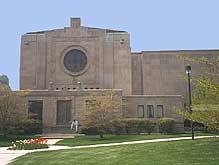Society of Jesus
The Society of Jesus (Spanish: La Compañía de Jesús). usually called Jesuits is a powerful worldwide Catholic religious order well known for its devotion to education, science and the ultramontane cause of the Pope. Founded in 1534, today it is active in 112 nations with over 20,000 members, working in the fields of education, intellectual research, cultural pursuits, missionary work, human rights and social justice.
The Jesuits were founded by Saint Ignatius of Loyola in 1534, to defend Catholicism against the Protestant Reformation and to do missionary work among the heathen. This religious order is better known by the name "Jesuits" ("Soldiers of Christ"). The Order is the largest order for men in the Catholic Church. It founded many schools in the US, including Fordham University in the Bronx, New York, Loyola University Chicago and Georgetown University in Washington, D. C. In the world it has about 56 university centers and 400,000 students, 28 Jesuit universities and colleges in the United States.
In 1773, under pressure by government officials in France, Spain and Portugal, Pope Clement XIV abolished the order, but the Russian Queen Catherine II the Great protected it there. Pressure to restart its educational programs led to the reinstatement of the Jesuits in 1814 by Pope Pius VII.
In the late 20th century through today, some Jesuits are criticized for being liberal rather than adhering to the doctrine of the Church. Many of the Jesuit colleges have become overrun by leftist professors and students.
Ignatius of Loyola wrote the Jesuit Constitutions, which created a tightly centralized organization and stressed absolute self-abnegation and obedience to the Pope. Jesuits do not have an official habit, although the mandate of the order was to dress in the manner of diocesan priests at the time. This has led to some Jesuit priests adopting an archaic habit of a black cassock tied at the waist with a white rope girdle (or amaranth during the Advent). Some priests may wear a biretta cap and cape to celebrate mass or walk among parishioners on feast days. Typically however, Jesuit priests wear a tab collar shirt as do diocesan priests.
Ad Maiorem Dei Gloriam
For the Greater Glory of God
Christ as the model of human life.
Contents
Spiritual Exercises
The spirituality practiced by the Jesuits, called Ignatian spirituality, is based on the Catholic faith and the Gospels. The purpose of St. Ignatius's "Spiritual Exercises" is to conquer oneself and to regulate one's life, based solely on the discern of God's will, who is ever active in people's lives.
The Sacred Heart and Our Lady
The Order has a commitment to spread the devotion to the Sacred Heart and to Our Lady, the Virgin Mary.
Jesuits and science
- Abbreviations of the names of three Jesuit-trained or Jesuit-financed scientists are to be found on almost every consumer electronic device or consumer appliance sold around the world.[1]
Distinguished Jesuits
- Ignatius Loyola;
- Francis Xavier;
- Francis Borgia;
- Stanislaus Kostka;
- Alfonso Rodriguez;
- Juan de Castillo;
- John Berchmans;
- John Francis Regis;
- Peter Claver;
- Francis de Geronimo;
- Paul Miki, John Goto, James Kisai, Japanese martyrs (1597)
- Peter Canisius;
- North American Martyrs: Isaac Jogues, Anthony Daniel, John de Brébeuf, Gabriel Lalemant, Charles Garnier, Noel Chabanel (priests), and Rene Goupil and John Lalande (lay missionaries);
- Robert Bellarmine,
- Andrew Bobola;
- Edmund Campion, English martyr.
- Teilhard de Chardin, French paleontologist and spiritual writer.
- Jorge Mario Bergoglio, elected Pope Francis in 2013
See also
- New France (Quebec)
- Baldomero Ortoneda
External links
- Georgetown University
- Jesuits and the Sciences: 1540-1995
- Loyola University Chicago
- Compañía de Jesús In Spanish.
- The Society of Jesus Catholic Encyclopedia.
- The Jesuit Priest
- St. Ignatius College Prep, Chicago, Illinois

